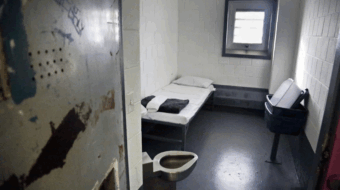WASHINGTON (PAI) – The Mine Workers are lauding an Obama administration plan to make it easier for the Mine Safety and Health Administration (MSHA) to crack down on coal companies who are constant safety violators.
But while UMWA President Cecil Roberts hailed MSHA’s proposed rules covering “pattern of violations” (POV) operators, Roberts also called for more specificity, to help prevent MSHA from backsliding in POV enforcement.
MSHA Administrator Joe Main, a former UMWA safety and health specialist, announced the proposed rules on Feb. 2. “As I’ve said many times before, the current POV system is broken, and this regulation is the next critical step in reforming the enforcement program under the existing statute,” Main said.
“It would require mine operators to be much more proactive in monitoring their compliance performance and would eliminate two provisions in the existing regulation: The potential POV procedure and the requirement regarding final orders,” he added.
Mine operators, particularly Massey Coal Co., use those sections – especially the one on final orders – to delay and defy mine safety law. Present rules let mine owners delay compliance with MSHA safety orders until the individual cases are finally settled.
Massey, which was recently sold, is the poster child for that tactic. It has contested every MSHA order, even after the fatal explosion and fire in its Upper Big Branch mine in West Virginia last year. The disaster killed 29 miners. Investigations showed that, contrary to Massey claims, its other mines are rife with uncorrected safety violations.
But MSHA’s present POV rules are so limited – and the constant appeals are such a roadblock – that MSHA couldn’t enforce them against Massey. The result has been years of delays in bringing mines into safety compliance. And in the case of a company like Massey, with a POV in all of its mines, rampant safety violations fester.
“Congress enacted this law 33 years ago, and not one mine has ever been placed on a POV,” Main said. The new proposal “is designed to meet Congress’ intent.”
Roberts praised the proposed new rules, but said everything depends on specificity and enforcement. “Regulations are just words written on paper. To become something that is followed – something that saves lives – they have to be enforced. We believe the current leadership of the Department of Labor and MSHA will use these tools. But who’s to say what may happen under a future leadership?”
Details of the proposed MSHA pattern of violation rules include:
* Specifying the general criteria MSHA would use to identify mines with a pattern of violations. The criteria would include compliance, accident, injury and illness records.
* Posting of specific POV criteria, along with compliance information, in a searchable (by mine) database, on the agency’s website. That would let mine owners “monitor their own records against the POV criteria and take proactive measures to eliminate persistent, systemic safety and health hazards, and bring their mines into compliance with MSHA safety and health standards and regulations,” MSHA said.
* Eliminating the “potential POV procedure, which involves written notification that a potential POV exists” at a mine. That cuts out advance warnings to mine owners and operators. MSHA would instead screen operators to see if their mines meet the POV criteria. If they do, MSHA will review the mine for POV twice a year, not yearly.
“MSHA believes the ready availability of compliance data on the website will eliminate the need to inform operators of a potential POV,” the agency said. Mine operators could submit evidence of written safety and health management programs aimed at finding and fixing problems, especially “significant and substantial” violations, in an attempt to avoid the POV label.
* The most important change, from UMWA’s view, is elimination of the present rule that “only citations and orders which have become final orders can be used in MSHA’s POV review. The existing requirement provides an incentive for operators to contest citations and results in final orders years after the violations have occurred.”
“For operators placed on a POV, each significant and substantial violation” found at a mine would result in an agency order closing the mine “until the violation is abated.” They would stay POV – and closed – until “a complete inspection” of the whole mine showed no S&S violations.
Besides MSHA’s proposed POV rule, there’s one other positive development for miners’ safety and health, Roberts reported: Massey, the fourth-largest coal company in the country, was sold. And the month before, Massey CEO Don Blankenship, who conducted Massey’s massive resistance to both MSHA and unionization, retired.
Massey’s buyer, Alpha Natural Resources, includes about 1,500 unionized miners, Roberts said. Alpha has “open lines of communication” with the Mine Workers and “we believe (Massey) workers” at Alpha “would be better off with a larger union presence,” he added.










